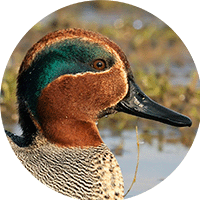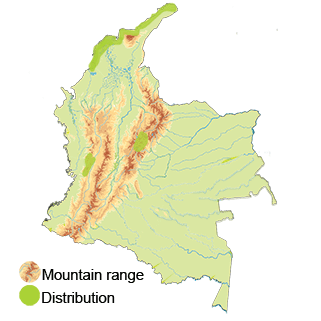Common Teal
Appearance: Adult male Common Teals (36 cm -14 inches) have a distinctive coloration with a chestnut head, green mask, yellowish-buff breast, and a white vertical stripe on their side. They have a dark brown back with a contrasting black tail. Females are less striking, featuring a mottled brown plumage. No white on face. Chestnut head.
Habitat: Common Teals inhabit freshwater bodies such as lakes, marshes, ponds, and flooded grasslands. They can also be found in brackish habitats like coastal lagoons and estuaries. In Colombia, they are found in both lowland and highland regions. Up to 2600 m altitude.
Behavior: Common Teals are highly migratory birds, traveling long distances between breeding and wintering areas. They are very active during the day and are known for their dabbling behavior—feeding by dipping their head underwater while grazing on aquatic vegetation, small invertebrates, and seeds.
Breeding: These ducks breed in the northern parts of their range. During the breeding season, males perform courtship displays, including raising their head toward the sky, whistling, and performing short flights. Nests are built on the ground in vegetation near water, and females lay a clutch of 8-11 eggs.
Conservation Status: The Common Teal is not considered a species of conservation concern.
Distribution
Coastal Regions: Common Teals can be observed in coastal areas of Colombia, including coastal lagoons, estuaries, and wetlands. These areas provide suitable habitats for the species during its wintering period. Notable locations include the Caribbean coast, such as the Ciénaga Grande de Santa Marta and the coastal wetlands of La Guajira.
Northern Colombia: The northern regions of Colombia, particularly in the department of La Guajira, serve as important areas for the Common Teal's winter migration. Wetland areas and rivers, such as the Rancheria and Sinú rivers, can be potential sites for observing these ducks.
High Andes: Some Common Teals may also be observed in the high Andes region during their winter migration. High-altitude wetlands and lakes, such as those in the páramo ecosystems, may serve as temporary habitats for these ducks.
Taxonomy
- Kingdom: Animalia
- Phylum: Chordata
- Class: Aves
- Order: Anseriformes
- Family: Anatidae
- Genus: Anas - Dabbling Ducks
- Species: Anas crecca
Vocalization
Male Courtship Call: During the breeding season, male Common Teals emit a distinctive whistle-like call. This call is a high-pitched, accelerating series of notes, often described as a "whew-whew-whew" or "qeet-qeet-qeet" sound. Males use this vocalization to attract females and establish their presence.
Female Calls: Female Common Teals produce a range of calls that vary in pitch and intensity. These can include soft quacks, low chuckles, and grunting sounds. These vocalizations serve as contact calls and may also function in maintaining group cohesion while foraging.
Alarm Calls: When Common Teals sense danger or perceive a threat, they emit an alarm call to alert others in the vicinity. This call is often a rapid series of loud, high-pitched quacking sounds. It serves as a warning to other ducks and helps coordinate a collective response for escaping potential danger.
Social Calls: Common Teal ducks engage in social vocalizations to maintain group cohesion and communicate within their social structure. These calls can include soft contact calls, rhythmic quacking, and a range of other soft vocalizations that allow individuals to stay in contact while foraging or flying in groups.





